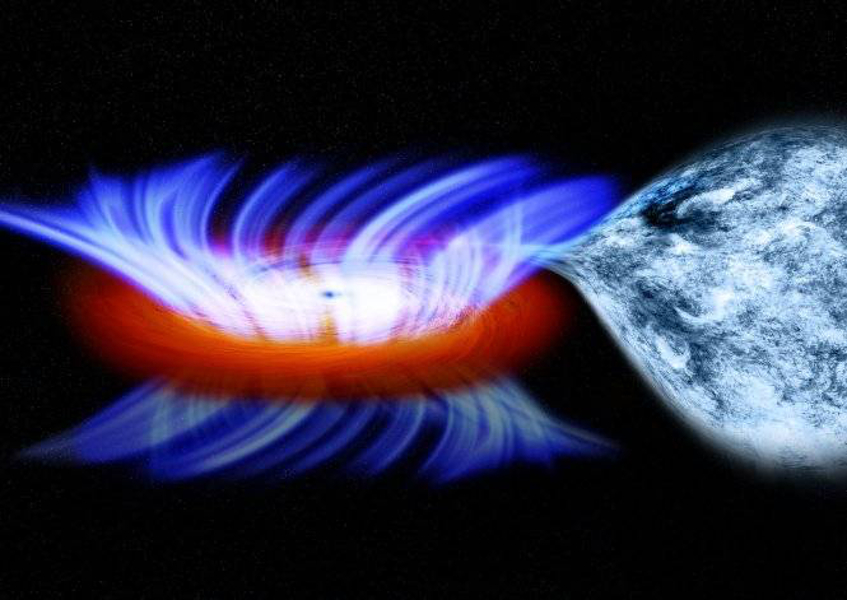
 Credit: NASA/CXC/M. Weiss
Credit: NASA/CXC/M. Weiss
Echoes in the Darkness
One of the most intriguing questions in astrophysics is what lies near the event horizon of a black hole. Things that fall through the event horizon effectively leave our Universe, so it's natural to wonder what happens to this material in its the final moments. Beyond a few times the radius of the event horizon, things are fairly stable, and material in theory can stay in orbit around the black hole for a long time. Very near the black hole, however, space behaves strangely, and orbits become unstable, and any matter there inexorably falls through the event horizon, never to be seen or heard from again. Because event horizons are tiny (only 3 km in radius for a black hole which has the same mass as the Sun) and at enormous distances, it's extremely difficult to directly take a picture of the region near the event horizon (but that doesn't stop people from trying). An easier way to study the spacetime near a black hole is to measure timing signals from the very hot gas that resides there. To do this you need a sensitive X-ray instrument which is capable of making measurements on very short (1/1000 of a second) timescales, and a bright outpouring of X-ray emission from an accreting black hole. The Neutron Star Interior Composition Explorer (NICER) on the International Space Station was primarily designed to study neutron stars, but it provides a large, sensitive X-ray observatory with very high time resolution which is nearly perfect for the study of accreting black hole systems. And on March 11, 2018, the MAXI X-ray monitor (also on the ISS) discovered a bright burst of X-rays never before seen from an extremely bright, accreting black hole binary system like that shown in the artistic illustration above. NICER swung into action, measuring the variation of these X-rays over a broad energy band and on extremely short timescales. Most of the accreting material forms a disk around the black hole before it spirals through the event horizon, and some of the this material forms a cloud of hot gas, called a corona, around the accretion disk. The X-ray variations showed different time lags, or echoes, at different energies and timescales, as X-rays from the corona were reflected off of different regions of the accretion disk. The X-ray echoes detected by NICER thus allowed astronomers a very rare peak at the distribution of matter very close to a stellar black hole. This revealed for the first time that the disk of accreting material extends very close to the event horizon, and allowed astronomers for the first time to also measure changes in the size of the hot, X-ray emitting corona.
Published: January 14, 2018
<
HEA Dictionary ● Archive
● Search HEAPOW
● Other Languages
● HEAPOW on Facebook
● Download all Images
● Education ● HEAD
>

Each week the HEASARC
brings you new, exciting and beautiful images from X-ray and Gamma ray
astronomy. Check back each week and be sure to check out the HEAPOW archive!
Page Author: Dr. Michael F. Corcoran
Last modified Monday, 26-Feb-2024 17:22:35 EST


